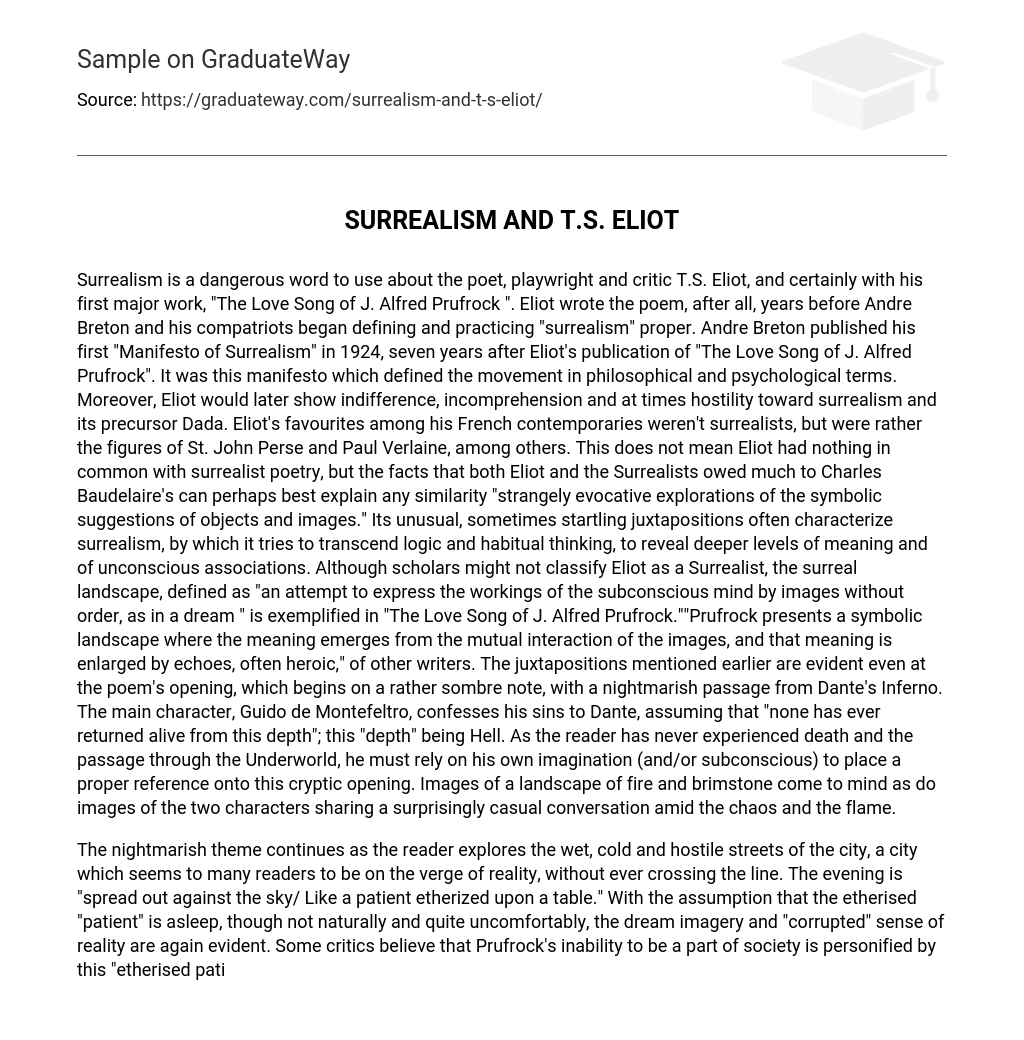Surrealism is a risky term to apply to T.S. Eliot, the poet, playwright, and critic. This is especially true for his initial significant creation, “The Love Song of J. Alfred Prufrock .” Eliot composed this poem long before Andre Breton and his colleagues established and pursued the true concept of “surrealism.”
Andre Breton wrote his initial “Manifesto of Surrealism” in 1924, a mere seven years after Eliot’s publication of “The Love Song of J. Alfred Prufrock.” The manifesto served as the defining articulation of the surrealist movement in terms of philosophy and psychology.
The text explains that Eliot had a lack of interest, lack of understanding, and sometimes even hostility towards surrealism and its precursor Dada. Instead, he preferred French contemporaries such as St. John Perse and Paul Verlaine. However, this doesn’t mean Eliot had no similarities with surrealist poetry. Both Eliot and the Surrealists were influenced by Charles Baudelaire’s focus on the symbolic implications of objects and images.
The surrealism movement often showcases unusual and surprising combinations in order to go beyond normal logic and thinking patterns and uncover deeper layers of meaning and unconscious associations. While Eliot may not be typically classified as a Surrealist, his poem “The Love Song of J. Alfred Prufrock” exemplifies a surreal landscape that aims to depict the workings of the subconscious mind through unordered dream-like imagery. Within this landscape, meaning emerges from the interactions between the images and is further enriched by echoes of other writers, often with heroic undertones.
The poem’s opening sets a sombre tone with a nightmarish passage from Dante’s Inferno. Guido de Montefeltro confesses his sins to Dante, believing that no one has ever returned alive from Hell. As the reader hasn’t experienced death or the Underworld, they must rely on their imagination to interpret this cryptic beginning. They may imagine a landscape of fire and brimstone, along with the two characters having a casual conversation amidst the chaos and flames.
The nightmarish theme persists as the reader explores the damp, chilly, and inhospitable streets of the city. This city appears to be almost real, but never quite crossing that line. The evening is compared to a patient under anesthesia on a table, stretched out against the sky. The use of “etherized” suggests that the patient is asleep in an unnatural and uncomfortable way, emphasizing the dream-like imagery and distorted sense of reality. Some critics see this “etherized patient” as a symbol of Prufrock’s inability to fit into society. The streets resemble scenes from an apocalyptic movie – dark, dirty, and sparsely populated. The reader is left questioning why Prufrock’s world is described in this way.
The poem starts with a somber tone, but quickly shifts to a contrasting lyrical couplet where women are conversing about Michelangelo. The stark difference between these scenes prompts the reader to question which one reflects Prufrock’s reality. Just as the reader begins to observe cleanliness and civility, Prufrock abruptly returns us to the nightmarish world mentioned earlier.
According to Eliot, the yellow fog that comes from St. Louis and crosses the Mississippi is likened to a beast, specifically a cat. The fog behaves like a cat, rubbing against windowpanes, licking its tongue, and even making sudden leaps. It engulfs the house and eventually falls asleep. This image of the cat is frequently employed in surrealism, symbolism, and fantasy genres.
The poem evokes memories of the Cheshire Cat from Lewis Carroll’s The Adventures of Alice in Wonderland or Edgar A. Poe’s short story “The Black Cat”. However, Prufrock’s descriptions transform what would normally be a lifelike landscape into a dark, distorted, and animated setting. This





